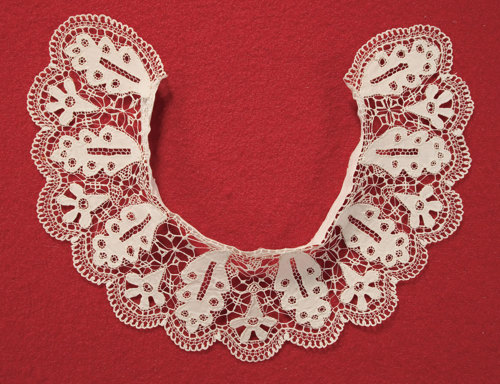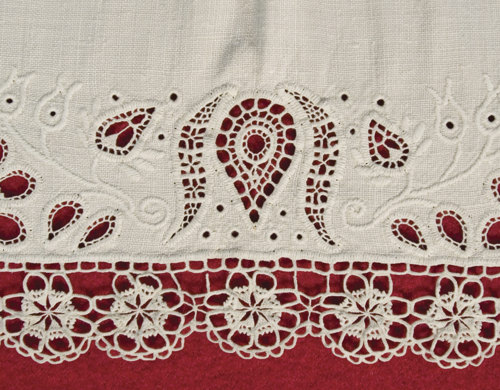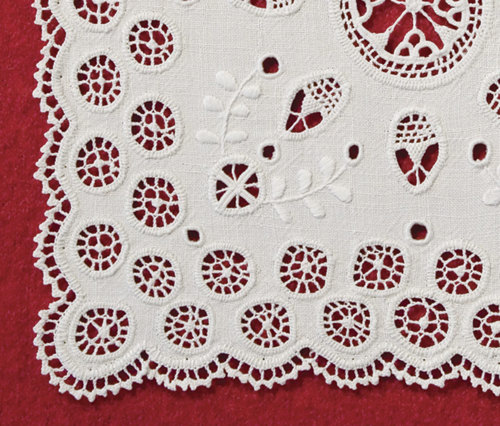Cut work Hedebo
Here on this page, you will find examples of textiles that incorporate the cut work Hedebo embroidery technique.

"Knædug" with "baldyring", square cut work, counted thread work and "hvidsøm"
The satin stitch bases are evenly spread over the canvas and bordered with tendrils and leaves in flat stitch. The fillings in the satin stitch bases are simple, consisting primarily of arches, points, and openwork. At the top, remnants of the monogram AADD can be glimpsed. The two leaves above the initials, unlike the rest of the embroidery, are filled with a whitework base. Below, before the warp plaiting, a border with square-cut embroidery featuring deer and stylized trees of life is visible.
Please note
- Two of the square bases in the top border and four in the bottom border are embroidered with cutwork Hedebo
- The bottom border, with square-cut embroidery, H-hole stitches, and warp plaiting, is of a different fabric quality
- The embroidered tendrils and leaves are executed with great embroidery skill, whereas many of the satin stitch bases lack this level of expertise
- The area with the monogram is worn thin, suggesting that old monograms may have been removed and new ones added





Cradle sheet with ”Baldyring” and cut work Hedebo
The cradle sheet has a centre motif in ”Baldyring”, surrounded by delicate vines of flowers in outline stitch and satin stitch with stiletto holes. The same type of flower vine is used in the motifs on the sides, but here the flower is embroidered in ”reverse cut work Hedebo”. The similarity in style between the flower arrangement motif in the middle and the side motifs raises the question of whether the filling in cut work was originally a ”Baldyring” filling.
Please note
- The frayed fabric in cut work Hedebo takes the form of an eightpointed star. The empty spaces in the star are filled with Danish buttonhole stitching, alternating with Hedebo wheels with small, solid points
- The three small blanket stitch leaves on the two flowers in the furthest corners
- There are only two patterns in the ”Baldyring” filling: scallop with beading loops, and point and scallop with two points. The second pattern is designed in such a way that it forms eight-pointed stars



Decorative towel with cut work Hedebo
The embroidery is dominated by the initials MOD, which are stitched in a rare technique where the letters are cut out of the fabric, and the letter openings are filled with a mesh of loose buttonhole stitches. It required great skill to maintain the shape of the letters. MOD stands for Mette Olsdatter. We do not know whether it was Mette herself or her mother who did the embroidery.
Please note
- The centers of three of the four rosettes in the wide upper border, where a small piece of plain-woven “fabric” encircled by buttonhole stitches, is sewn with yarn. Is this technique seen elsewhere?
- The four upper horizontal "eyelet seams" are rows of embroidery
- The lower "eyelet seam" in the wide border is a seam joining the two fabric pieces of the decorative towel. The seam consists of arches sewn onto both fabric pieces, connected by an openwork passage
- The purchased fringe is attached with small loop stitches resembling an eyelet seam




Two collars in ”reverse cut work hedebo”
Both collars are composed of fabric cut into leaves and rosettes consisting of smaller Hedebo rings. On the one collar, an oval hole in the centre of the leaf is filled with needle lace. On the other collar, the leaf is filled with three holes with beading loops and nine stiletto holes. The rosettes on the one collar consist of Hedebo rings filled with beading loops and picots, and have beading loops in the very centre. On the other collar, the rings in the rosettes are empty. Inside the ring of Hedebo rings is a fabric circle with beading loops in the hole in the centre. The different parts of both collars are sewn together with a row of open Danish buttonhole stitching.
Please note
- Along both collars’ edges there is a narrow linen ribbon. On one of the collars the ribbon forms five loops on its way round
- The outer edge of one collar has a circular piece of fabric with points on its edge which is cut into sections and finished with beading loops and scallops with picots.
- The composition of the two collars is alike with leaves, rosettes, and large rings


Collar in ”reverse cut work Hedebo”
The concept of needle lace is clearly seen here. It is the same technique as is used to fill out the spaces in cut work Hedebo, but here it is the needle lace which holds the collar together. The collar consists of eight oakleaf-like pieces of fabric, alternating with seven pieces of a different leaf shape. The pieces are joined by needle lace in a very thin thread. A ribbon constitutes the inner edge of the collar. Alongside the scalloped edge of the collar is a row of a K border. Due to the fine thread used, the collar stands out like bobbin work. ”Reverse cut work Hedebo” and this collar type were likely to have been embroidered around 1850-1865.
Bemærk
- The two leaf types were first embroidered with cut work Hedebo, then cut out and assembled with needle lace embroidery
- The small point inside the beading loops of the small leaves
- The edge of the collar is narrow needle lace
- The ribbon up against the neck


Collar with cut work Hedebo and a Hedebo edge
The collar is full of detail and dominated by two large tulips on the sides. Around the tulips are round and oval cut spaces with beading loops and crosses. The oval and square cut spaces around the centre are filled with beading loops with many picots. The single motifs are connected with small vines and leaves embroidered in satin stitch. The lace consists of 34 half rosettes made up of seven Hedebo rings with scallops, and filled with points and cross threads. The collar’s form and composition suggests that this collar is from around 1890.
Please note
- The right angled frame of a single and double row of squared ”Baldyring” spaces. The row finishes neatly at the edge
- The filled ”Baldyring” row in the collar’s centre, above the half rose and the two squares
- The row of tilted scallops along the inner side of the collar, which indicates that the lace was embroidered as a single unit, and attached later to the collar
- The many whole and half buttonhole scallop wheels



Collar with cut work Hedebo
The form of the collar suggests that it was embroidered in the period 1865-1880. If one compares the fine French embroidery under the lancet shaped leaves, done by a skilful needlewoman , with the more shaky satin stitches between the spaces along the edge, the question arises of whether this collar was stitched by several needlewomen, or by the same needlewoman with several years in between. In the centre of the back, a large round cut space, filled with Hedebo rings with points, can be seen. This also deviates technique-wise from the filling of the other spaces.
Bemærk
- The ”Baldyring”-like squares in the tulips. They are woven over by thread both horizontally and vertically, after which the spaces are filled, which at first glance might be mistaken for ”Baldyring”
- The collar is finished all around with diagonal scallops, decorated on their edges with picots
- The many cut shapes and different techniques, which together create a bewilderment of styles



Collar with cut work Hedebo and a Hedebo edge
The pattern composition is vigorous, unrestrained, and a stylish mixture. The needlewoman used all the available shapes of cut work Hedebo fillings she could think of. The many rosettes consist of round, leaf-shaped, and heart-shaped cut spaces with fillings combined with stiletto holes. The needle lace consists of beading loops, K border and points, some of them with picots. The embroidered lace consists of tilted scallops and a row of large ‘wheels’. Inside the wheels, a so-called ‘spider’ is embroidered. The collar is likely to be from around 1900.
Please note
- The stiletto holes and the satin stitching are embroidered with somewhat thicker cotton thread than the rest
- The rosettes of the needle lace are made of an unusually large ring in the middle, with 8 points on the edge connected by beading loops
- The rosettes are sewn to a row of tilted scallops at the collar’s edge, and are connected at the ends by a row of scallops
- The tightly filled leaves in the scallops on the sides, and along the straight edge at the bottom



Collar cut off a shift and embroidered with cut work Hedebo
The shape indicates that the collar was embroidered in the middle of the 19th century. Between the cut out flowers and half rosettes, there are vines and leaves of outline stitch and satin stitch, combined with stiletto holes. The fillings are mainly tilted scallops and beading loops. The collar is edged with a needle lace, consisting of 280 Hedebo rings. Inside the rings, beading loops and three points are embroidered, and on the outside larger point thread ends are used to make Hedebo wheels consisting of eight rings.
Please note
- The centre ring of the drop-like open space in the tulip motif at the centre of the collar was added after the other fillings
- In the leaves on each side of the tulips, and in the tree-shaped cut spaces below the half rosettes in the corners, buttonhole bars cross the cut spaces, thus making the filling look like ”Baldyring”
- The many stiletto holes, which are used as flower buds as well as in and alongside the flower vines
- The Hedebo wheels were joined in a long row before they were attached to the collar



Collar with cut work Hedebo
Collar in finer fabric with cut work Hedebo and French embroidery from the period 1910-1925. This collar is the most recent of all the exhibited collars. It is different in many ways from the peasant collar above, and is likely to have been embroidered from a pattern sample from the company Oehlenschlægers Eftf. The embroidery of the cut out spaces is very plain beading loops, scallops, and points made with linen thread. Here there are many similarities with the embroidery of the peasant collar, but it lacks its variety. The French embroidery is done with mercerised cotton thread, which is also used for the scallops, which are embroidered with laid blanket stitches. The collar was made by an experienced needlewoman.
Please note
- The large vigorous motifs in the ‘corners’ on the shift’s collar are replaced with a tight and calm embroidery
- The designer, as shown by the pointy ovals, was inspired by the old embroideries
- The vines and flowers with stiletto holes of the old collar (10.7) are replaced true example of a heavy French embroidery, and by circular spaces with beading loops
- The needle lace at the edge of the old collar is replaced by precise and beautifully stitched scallops



Collar and serviette in cut work Hedebo
The collar has large distinctive scallops, typical for the period around the year 1900. The large patterns of the collar consist of leaf and half moon-shaped cut spaces, grouped in a manner that forms flowers. The main motif of the serviette is a large circular cut space, surrounded by eight drop-shaped spaces. The cut spaces in both the collar and the serviette are filled with needle lace. The collar has much greater variation than the serviette, which was probably made 10-20 years after the collar. Both are finished with scallops with circular cut spaces in every scallop.
Please note
- The beautiful French embroidery on the collar which is replaced on the serviette by plain sewn satin stitch
- All the 83 round spaces along the collar’s edge are filled with ‘spiders’, and not with traditional beading loops. On the serviette both “spiders” and beading loops can be seen
- The serviette might be embroidered from a pattern in a needlework magazine, which, at the beginning of the 20th century, enabled mass production of cut work Hedebo



Cut off shift collar and serviette with cut work Hedebo
The curved shape of the collar represents a transition from rectangular shift collars to the neck shaped collars of bourgeois dresses. It is likely to have been embroidered in the period 1850-1865. 1920 is probably the correct date of the serviette. The collar is an example of early cut work hedebo done in a strict composition. The two textiles have many similarities at first glance, but a closer look reveals similar patterns embroidered with different techniques.
Please note
- The round cut spaces of the collar are embroidered with a K border and ordinary beading loops. The fillings of the serviette are ordinary beading loops
- The scallop-shaped edge of the collar consists of beading loops and two rows of tilted scallops, whereas the serviette is finished with two rows of beading loops and a row of ordinary buttonhole scallops with picots
- The six picots in the circles in the drop-shaped cut spaces of the collar
- The rather uneven placement of drops on the edge of the collar, which might suggest that the needlewoman was not trained in cut work Hedebo


